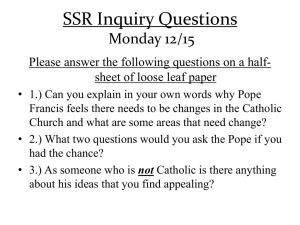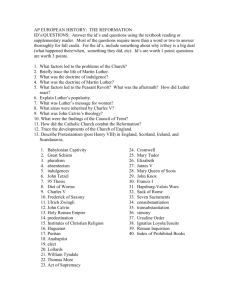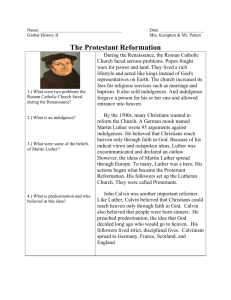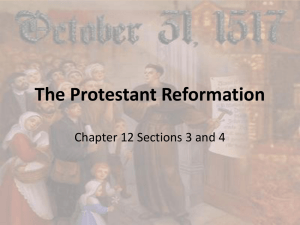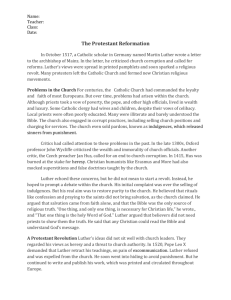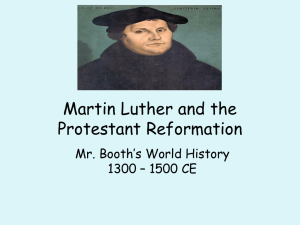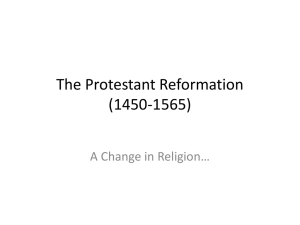The Reformation and The Scientific Revolution (1450
advertisement
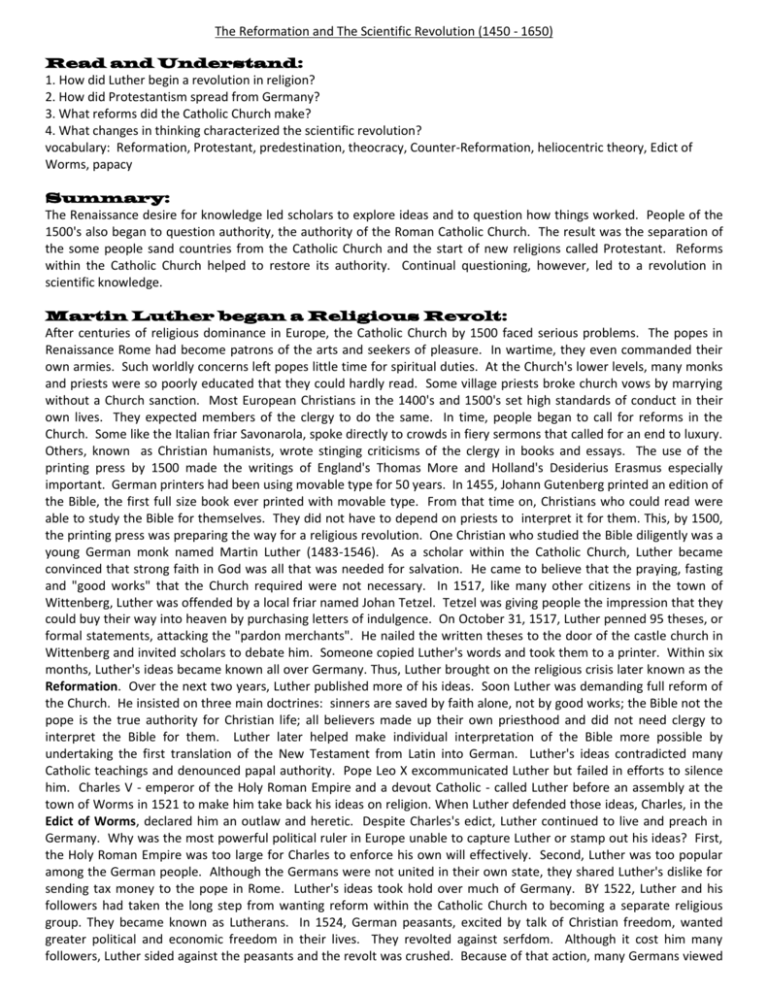
The Reformation and The Scientific Revolution (1450 - 1650) Read and Understand: 1. How did Luther begin a revolution in religion? 2. How did Protestantism spread from Germany? 3. What reforms did the Catholic Church make? 4. What changes in thinking characterized the scientific revolution? vocabulary: Reformation, Protestant, predestination, theocracy, Counter-Reformation, heliocentric theory, Edict of Worms, papacy Summary: The Renaissance desire for knowledge led scholars to explore ideas and to question how things worked. People of the 1500's also began to question authority, the authority of the Roman Catholic Church. The result was the separation of the some people sand countries from the Catholic Church and the start of new religions called Protestant. Reforms within the Catholic Church helped to restore its authority. Continual questioning, however, led to a revolution in scientific knowledge. Martin Luther began a Religious Revolt: After centuries of religious dominance in Europe, the Catholic Church by 1500 faced serious problems. The popes in Renaissance Rome had become patrons of the arts and seekers of pleasure. In wartime, they even commanded their own armies. Such worldly concerns left popes little time for spiritual duties. At the Church's lower levels, many monks and priests were so poorly educated that they could hardly read. Some village priests broke church vows by marrying without a Church sanction. Most European Christians in the 1400's and 1500's set high standards of conduct in their own lives. They expected members of the clergy to do the same. In time, people began to call for reforms in the Church. Some like the Italian friar Savonarola, spoke directly to crowds in fiery sermons that called for an end to luxury. Others, known as Christian humanists, wrote stinging criticisms of the clergy in books and essays. The use of the printing press by 1500 made the writings of England's Thomas More and Holland's Desiderius Erasmus especially important. German printers had been using movable type for 50 years. In 1455, Johann Gutenberg printed an edition of the Bible, the first full size book ever printed with movable type. From that time on, Christians who could read were able to study the Bible for themselves. They did not have to depend on priests to interpret it for them. This, by 1500, the printing press was preparing the way for a religious revolution. One Christian who studied the Bible diligently was a young German monk named Martin Luther (1483-1546). As a scholar within the Catholic Church, Luther became convinced that strong faith in God was all that was needed for salvation. He came to believe that the praying, fasting and "good works" that the Church required were not necessary. In 1517, like many other citizens in the town of Wittenberg, Luther was offended by a local friar named Johan Tetzel. Tetzel was giving people the impression that they could buy their way into heaven by purchasing letters of indulgence. On October 31, 1517, Luther penned 95 theses, or formal statements, attacking the "pardon merchants". He nailed the written theses to the door of the castle church in Wittenberg and invited scholars to debate him. Someone copied Luther's words and took them to a printer. Within six months, Luther's ideas became known all over Germany. Thus, Luther brought on the religious crisis later known as the Reformation. Over the next two years, Luther published more of his ideas. Soon Luther was demanding full reform of the Church. He insisted on three main doctrines: sinners are saved by faith alone, not by good works; the Bible not the pope is the true authority for Christian life; all believers made up their own priesthood and did not need clergy to interpret the Bible for them. Luther later helped make individual interpretation of the Bible more possible by undertaking the first translation of the New Testament from Latin into German. Luther's ideas contradicted many Catholic teachings and denounced papal authority. Pope Leo X excommunicated Luther but failed in efforts to silence him. Charles V - emperor of the Holy Roman Empire and a devout Catholic - called Luther before an assembly at the town of Worms in 1521 to make him take back his ideas on religion. When Luther defended those ideas, Charles, in the Edict of Worms, declared him an outlaw and heretic. Despite Charles's edict, Luther continued to live and preach in Germany. Why was the most powerful political ruler in Europe unable to capture Luther or stamp out his ideas? First, the Holy Roman Empire was too large for Charles to enforce his own will effectively. Second, Luther was too popular among the German people. Although the Germans were not united in their own state, they shared Luther's dislike for sending tax money to the pope in Rome. Luther's ideas took hold over much of Germany. BY 1522, Luther and his followers had taken the long step from wanting reform within the Catholic Church to becoming a separate religious group. They became known as Lutherans. In 1524, German peasants, excited by talk of Christian freedom, wanted greater political and economic freedom in their lives. They revolted against serfdom. Although it cost him many followers, Luther sided against the peasants and the revolt was crushed. Because of that action, many Germans viewed Luther as an enemy of the people. Some of Germany's ruling process, meanwhile had converted to Lutheranism. In 1529, princes still loyal to the pope agreed to join forces against Luther's ideas. The Lutheran princes signed a protest against the Agreement. Those princes became known as Protestants. Eventually, the term Protestant was used for many Christians who turned away from the papacy and the Catholic Church. Their movement was commonly known as the Protestant Reformation. Protestantism Spread In Northern Europe: As time passed, the Protestant Reformation challenged the Catholic Church in many parts of Europe. One of the countries was England, where the Tudor king, Henry VIII, had held the thrown since 1509. By 1527, Henry's wife, the Spanish Catherine of Aragon, had born a daughter but no male heir to the throne. As a devout and loyal Catholic, Henry asked Pope Clement II to allow him to divorce Catherine. Henry had already decided to marry young Anne Boleyn, who Henry hoped would bear him a son. The Pope, however, would not grant the divorce. In 1529, Henry asked Parliament to pass laws that would solve his marriage problem. Parliament obligingly legalized Henry's divorce, and Henry married Anne. Other laws weakening the Church's role in England hollowed until in 1534, Parliament's Act of Supremacy made Henry not the pope the official head of England's church. This, England broke away from the Catholic Church. To cement his control of religion in England, Henry close Catholic monasteries and seized Church wealth and lands. Much of the wealth he distributed to members of England's nobility and its middle class thus securing their support. After Henry's death his three children in turn inherited his thrown. Although Mary, daughter of Catherine, was Catholic, the other two Edward and Elizabeth further strengthened English Protestantism. While England was establishing its own church, other forms of Protestantism developed elsewhere. In the 1530's, a thoughtful young student named John Calvin joined Protestant groups in France. When the Catholic king of France ordered the Protestants arrested, Calvin fled to Switzerland. Calvin's work gave a strong sense of order of the new Protestant faith. His book Institutes of the Christian Religion set forth a systematic Protestant philosophy. In his doctrine of predestination, Calvin taught that God's grace will save only a few people from sin. Calvin called those people the "elect". Furthermore, Calvin thought that the elect should rule society for the glory of God. In this, he was proposing a theocracy or government by church leaders. A community of Protestants in the city of Geneva, Switzerland, gave Calvin the chance to set up a theocracy. To many Protestants, Geneva of the mid 1500's was a "city of saints". Calvin's "saints" wore dark clothes, attended classes in religion and lived strictly regulated lives. As a center of Protestant learning, Geneva drew many visitors. One of these was John Knox, a Scottish Protestant. When he returned to Scotland in 1559, he put Calvin's ideas on church organization to work in Scottish towns. Knox's followers in Scotland became known as Presbyterians. In 1567, Knox and the Presbyterians succeeded in making Calvinism Scotland's official religion. By the mid 1500's Protestant churches had spread to many countries of Europe. The Catholic Church Makes Reforms: While the new Protestant faiths developed and spread, waves of reform went through the Catholic Church itself. Historians call the reform movement by two names: The Counter-Reformation or the Catholic Reformation. One of the champions of Catholic reforms was a young Spaniard named Ignatius of Loyola, later he would be canonized as Saint Ignatius. Ignatius had been a soldier in the Spanish Army. During a long recovery from a battle wound, he took comfort in his daily devotions. In 1522, Ignatius wrote Spiritual Exercises a book outlining daily routines for prayer and study. Over the next 18 years Ignatius attracted hand of followers. In recognition of his works, the pope made Ignatius's company a new monastic order called the Society of Jesus. Those who joined later were commonly called Jesuits. The Jesuits exacted strict discipline and obedience among their members. They concentrated on building excellent schools for priests, sending missionaries to non-Christian Lands and stemming the spread of Protestantism. Two popes, Paul III and Paul IV, made sweeping reforms that helped to restore strength and unity within the Church. Paul III who had approved the Jesuit order, directed a thorough investigation of misconduct among the clergy. Most important of all, he called bishops and cardinals together in Trent Italy. The religious leaders at the Council of Trent restated Catholic beliefs and agreed that they would not accept Luther's reform doctrines. Paul IV vigorously carried out the council's decree. He also ordered bishops together and burn books containing teachings offensive to the Church. Charles V tried to use military measure to rid Germany of Protestantism, but Germany's Catholic princes refused to help him. In 1555, the weary and discouraged Charles sought peace at the meeting of German princes held in the city of Augsburg. Under; the terms of the Peace of Augsburg, each prince could choose whether his stat was to be Catholic or Lutheran. Soon, Charles divided his realms between his son and brother, then retired to a monastery. The peace of Augsburg brought a temporary calm to Europe. The the seeds of greater religious and political disunity had been sown. Luther had stress the importance of the individual's thought in religion and had challenged the central authority of the pope. In years to come, other people would begin to stress the importance of the individual in politics and government and the challenge the authority of kings. Scientists Challenged Old Assumptions: Renaissance scientists, like Renaissance artists, studied the works of ancient Greeks and Romans. They began questioning and testing the validity of ancient science. The Polish scholar Nicolaus Copernicus was one of the first. He studied the works of Ptolemy, an ancient Greco-Roman astronomer, who had said that the sun and planets revolve around Earth. Europeans had believed Ptolemy for 1400 years. In 1543, Copernicus published a book that argued a new Heliocentric theory that the Earth and the other planets revolved around the sun. The new theory developed by Copernicus gained little attention in the 1500's. Early in the 1600's however, other scientists began to support Copernicus's clams after directly observing the motion of planets. One of these scientists was the Italian Galileo Galilei, who made his observation through a telescope. The telescope along with the microscope, thermometer and barometer gave scientists precise instruments for making observations. The observations of scientists sometimes conflicted with the teachings of the Church. Jesuits attacked Galileo's support of the theory of Copernicus because it seemed to lessen the importance of humanity's place in the universe. Later, the pope sentenced Galileo to house arrest for the last nine years of his life. Even so, the revolution Galileo had helped start went on. Connecting Past and Present: Black-robed Jesuit priests were among the major missionaries who accompanied European explorers and colonists to distant lands. Jesuits today are still active in education around the world. In many countries, such as those of Latin America, leaders have been educated in Jesuit schools and universities. This role carries risks as well. In El Salvador in 1989, six Jesuit priests were murdered, apparently for political reasons. There are still 28 major universities in the USA in today's world, some of them are: University of Seattle, Gonzaga University, University of San Fransisco, Loyola Marymount, Creighton University, Marquette University, Xavier University, Boston College, Fordham University and Georgetown University. Class work Define the following terms: Reformation Protestant predestination theocracy counter-reformation heliocentric theory - Identify the following: Thomas More Desiderius Erasmus Johann Gutenberg Martin Luther Wittenberg Reformation Charles V Edict of Worms Protestant Reformation Henry VIII John Calvin John Knox Council of Trent Catholic Reformation Ignatius of Loyola Peace of Augsburg Copernicus Ptolemy Galileo Galilei - Answer the following questions: 1. What were the three main points of Luther's reform doctrine? 2. How did Charles V respond to Luther's ideas? 3. In what various ways did Protestantism spread? 4. How did the Counter-Reformation strengthen the Catholic Church? 5. What were the outcomes of the Peace of Augsburg? Use your Best Effort to Answer With Critical Thinking - Short Essay: In what ways was science revolutionary? (Answer on back of page in sentence format)
